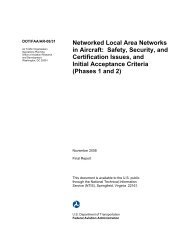Published Report (DOT/FAA/CT-94-36)
Published Report (DOT/FAA/CT-94-36)
Published Report (DOT/FAA/CT-94-36)
Create successful ePaper yourself
Turn your PDF publications into a flip-book with our unique Google optimized e-Paper software.
a. NTZ transgression frequency:<br />
b. NBO frequency;<br />
c. Parallel conflict frequency (i.e., conflicts between<br />
aircraft on different approach courses); and<br />
d. Parallel conflict slant range miss distances.<br />
Any conflict that resulted in a CPA less than 500 ft was<br />
considered a TCV and was investigated to determine its<br />
operational impact. A comprehensive review of TCV's, including<br />
audio/visual information, controller-pilot communications, and<br />
computer data, was conducted to ascertain whether any single<br />
factor contributed to the severity of the conflict.<br />
The communication frequencies of the blundering and evading<br />
aircraft and visual components of each run were recorded on a<br />
Super-VHS video cassette recorder. Complete audio recordings<br />
were made using a 20-channel DI<strong>CT</strong>APHONE audio recorder and a 9-<br />
channel IONICA audio recorder. Both the DI<strong>CT</strong>APHONE and<br />
the IONICA systems were recorded from the AMECOM system and<br />
operated independent of one another and the TGF operating system.<br />
3.1.1 0 uestionnaires and Observer Loas.<br />
After controllers participated as a monitor controller, they<br />
completed a Post-Run Controller Questionnaire. This<br />
questionnaire addressed the level of activity, stress, and mental<br />
effort they experienced during the run. When a TCV occurred,<br />
controllers described the incident on a TCV Statement.<br />
Controllers also completed a Post-Simulation Questionnaire at the<br />
conclusion of their participation in the simulation. The Post-<br />
Simulation Questionnaire addressed the operational viability of<br />
the display, the equipment, and the runway configuration. A copy<br />
of these questionnaires can be found in appendix F.<br />
Technical observers, simulation observers, and site coordinators<br />
each recorded information using logs designed specifically for<br />
their task. In general, the logs were devised to permit<br />
observers to record information pertaining to blunders, TCV's,<br />
NBO's, simulation problems, and the like, without being<br />
distracted from their task. Site coordinator logs were developed<br />
more specifically to record approach information. A copy of<br />
these logs can be found in appendix J. Information provided by<br />
these logs was used, along with the controller questionnaires, to<br />
support computer data files.<br />
3.2 ACCEPTANCE CRITERIA.<br />
This simulation evaluated the ability of controllers using FMA<br />
displays to monitor final approach traffic at DIA. As stated in<br />
18

















